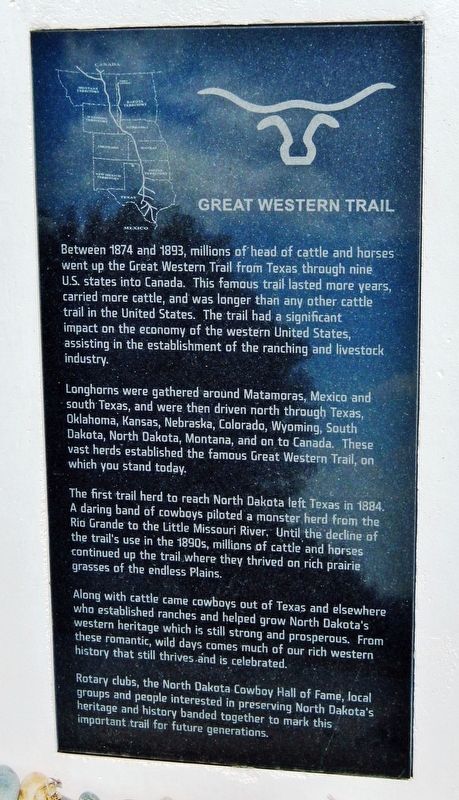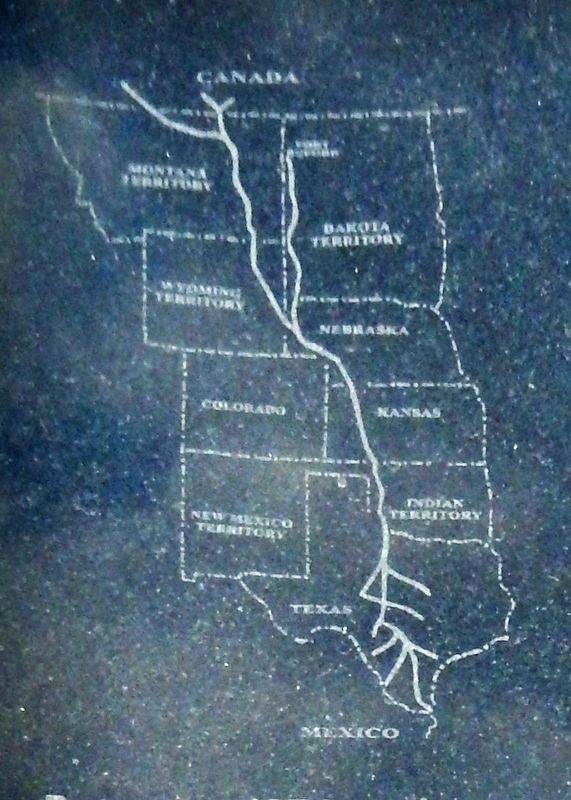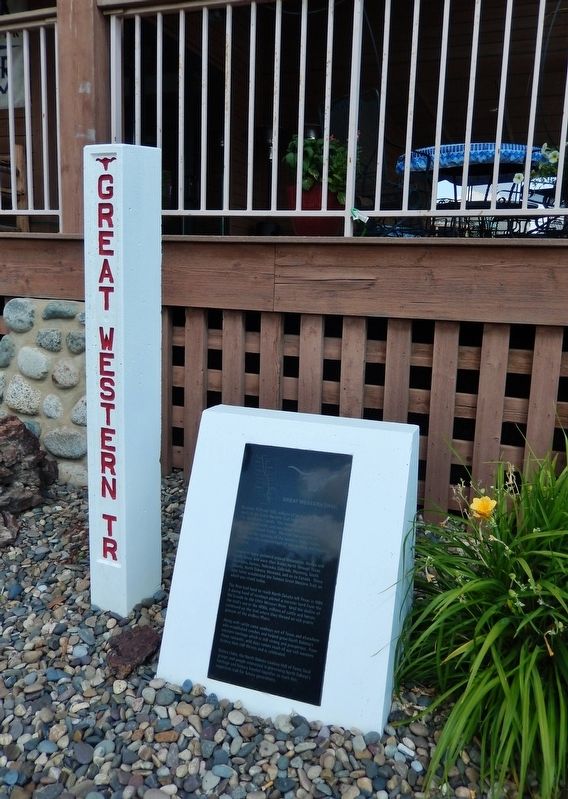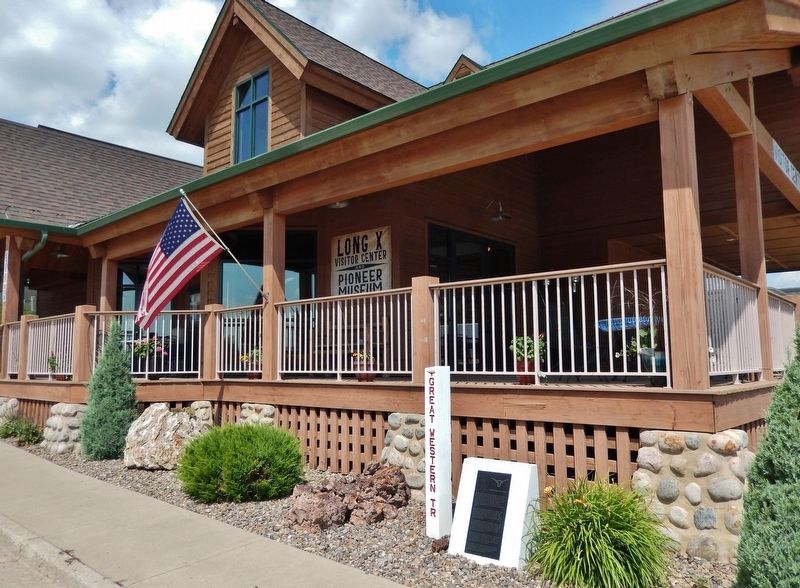Watford City in McKenzie County, North Dakota — The American Midwest (Upper Plains)
Great Western Trail
Between 1874 and 1893, millions of head of cattle and horses went up the Great Western Trail from Texas through nine U.S. states into Canada. This famous trail lasted more years, carried more cattle, and was longer than any other cattle trail in the United States. The trail had a significant impact on the economy of the Western United States, assisting in the establishment of the ranching and livestock industry.
Longhorns were gathered around Matamoras, Mexico, and south Texas, and were then driven north through Texas, Oklahoma, Kansas, Nebraska, Colorado, Wyoming, South Dakota, North Dakota, Montana, and on to Canada. These vast herds established the famous Great Western Trail, on which you stand today.
The first trail herd to reach North Dakota left Texas in 1884. A daring band of cowboys piloted a monster herd from the Rio Grande to the Little Missouri River. Until the decline of the trail’s use in the 1890s, millions of cattle and horses continued up the trail where they thrived on rich prairie grasses of the endless Plains.
Along with cattle came cowboys out of Texas and elsewhere who established ranches and helped grow North Dakota’s western heritage which is still strong and prosperous. From these romantic, wild days comes much of our rich western history that still thrives and is celebrated.
Rotary Clubs, the North Dakota Cowboy Hall of Fame, local groups and people interested in preserving North Dakota’s heritage and history banded together to mark this important trail for future generations.
Topics and series. This historical marker is listed in these topic lists: Animals • Industry & Commerce • Roads & Vehicles • Settlements & Settlers. In addition, it is included in the Rotary International series list. A significant historical year for this entry is 1874.
Location. 47° 47.984′ N, 103° 17.003′ W. Marker is in Watford City, North Dakota, in McKenzie County. Marker can be reached from the intersection of 2nd Avenue Southwest and Main Street South (State Highway 23), on the left when traveling west. Marker is located near the southeast corner of the Pioneer Museum-McKenzie County. Touch for map. Marker is at or near this postal address: 100 2nd Avenue Southwest, Watford City ND 58854, United States of America. Touch for directions.
Other nearby markers. At least 8 other markers are within 14 miles of this marker, measured as the crow flies. The Schafer Jail (approx. 4˝ miles away); a different marker also named The Schafer Jail (approx. 4˝ miles away); Man and Grass (approx. 12.9 miles away); Bentonitic Clay (approx. 13 miles away); North Dakota Badlands (approx. 13.6 miles away); Long X Cattle Trail (approx. 13.8 miles away); Building From Hard Times (approx. 13.9 miles away); The View that Launched a Park (approx. 13.9 miles away). Touch for a list and map of all markers in Watford City.
Also see . . .
1. Great Western Cattle Trail.
The Great Western Cattle Trail was first traveled by Captain John T. Lytle in 1874 when he was transporting 3,500 longhorn cattle up from Southern Texas into Nebraska. In five short years, it became one of the most traveled and famous cattle trails in U.S. history. Despite its popularity, traffic along the trail began to decline in 1885 due to the spreading use of barbed wire fences and legislation calling for a quarantine of Texas cattle due to the "Texas Fever", a disease spread by ticks. The last major cattle drive up the trail ended in Deadwood, South Dakota, in 1893. By that time an estimated six to seven million cattle and one million horses had traversed the trail.(Submitted on August 2, 2022, by Cosmos Mariner of Cape Canaveral, Florida.)
2. The Great Western Cattle Trail.
The Great Western Cattle Trail, also known as the Western Trail, Fort Griffin Trail, Dodge City Trail, Northern Trail, and Texas Trail, wasn’t as well known as some of the other cattle trails, but it was longer and carried cattle for two years longer than did the Chisholm Trail. Moving 10-12 miles a day, a typical cattle drive would take about two months to travel from South Texas to Kansas. Though the cattle could be driven as far as 25 miles in a single day, they would lose too much weight and be hard to sell when they reached the end of the trail. If the cattle were skillfully managed, they could gain weight along the trail.(Submitted on August 2, 2022, by Cosmos Mariner of Cape Canaveral, Florida.)
Credits. This page was last revised on August 2, 2022. It was originally submitted on July 30, 2022, by Cosmos Mariner of Cape Canaveral, Florida. This page has been viewed 176 times since then and 37 times this year. Photos: 1. submitted on August 1, 2022, by Cosmos Mariner of Cape Canaveral, Florida. 2, 3, 4. submitted on August 2, 2022, by Cosmos Mariner of Cape Canaveral, Florida.



